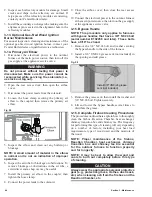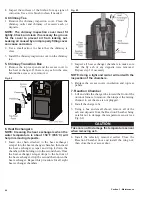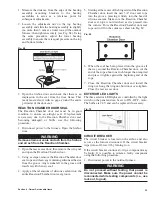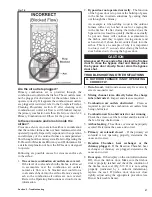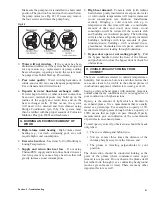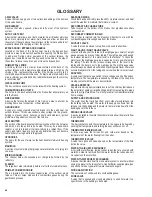
59
Section 5 - Troubleshooting
Fig. 79
4. Load of wood too large in relation to coal bed -
Adequate coals are needed to restart the fire after
adding wood. If adding too much wood causes the
fire to go out, either add drier, smaller pieces of
wood first or partially fill with wood to allow time
for the coals to restart the fire.
5. Water temperature setpoint too low - Set the water
temperature setpoint higher (see Adjusting Water
Temperature Setpoint).
6. Water temperature differential too large - Set the
water temperature differential to a smaller value (see
Changing Control Variables).
7. Too much time between idle pulses of air - Reduce
the time between idle pulses of air (see Changing
Control Variables).
8. Length of pulse of air too short - Increase the
amount of time the pulse of air is provided (see
Changing Control Variables).
9. Not enough ash in the firebox - Some ash, but not
more than three inches, on the sides and bottom of
the firebox is necessary for the proper operation of
the outdoor furnace (as shown in Fig. 46). No ash
should cover the mixing channel (the area alongside
the secondary air charge tube). Ash acts as an
insulator, keeping the glowing coals in the bottom
of the firebox hot enough to restart the fire when
needed after being in idle mode.
10. Optional gas-fired wood ignition not operating -
Check that the supply valve is turned on, the propane
tank is not empty and that Wood Auto Relight is
enabled. Refer to the gas-fired wood ignition manual
for more information.
C. BUILDING IS LOSING TEMPERATURE
1. Circulation valve(s) closed - Be sure the proper
valves in the system are open to allow circulation.
2. Circuit breaker off - If there is a circuit breaker that
supplies power to the outdoor furnace, check that it
is on.
3. Circuit breaker on airbox off - Check that the
circuit breaker switch on the airbox is on. If the
circuit breaker has tripped, determine the cause
before resetting it.
4. Circulation pump(s) not operating - Check that
circulation pumps are operating. If not, disconnect
power to the pump. Close valves at the pump.
Disassemble the pump and try to turn the pump
shaft. If the shaft is stuck, replace the pump cartridge.
Replace only the cartridge whenever possible. If
necessary, replace the pump. Follow instructions
supplied with the pump.
5. Air in system - Check for air in the water lines or
heat exchangers. If you hear a gurgling sound in a
heat exchanger, air is present in the system. Shut off
the pump, wait 15 seconds and start the pump. If it
is necessary to force air from lines, refer to Initial
Start-up Procedures.
6. Building(s) poorly insulated or uninsulated -
Poorly insulated or uninsulated buildings, buildings
with uninsulated or poorly insulated ceilings, or a
lack of proper insulation under radiant flooring can
cause excessive fuel consumption and or heating
problems.
7. Supply and return lines installed incorrectly - Make
sure the hot supply line is connected to the correct
fitting on the outdoor furnace and heat exchanger.
8. Circulation pump(s) installed backwards - Check
that pump flow direction is correct. If not, shut off
power to pump. If the flow is not in the correct
direction, disconnect pump from water line and
reverse pump mounting to correct flow direction.
If the pump is not mounted on the outdoor furnace,
check for proper pump mounting location (see Fig.
15).
9. Underground supply and return lines insulated
poorly - Heat loss from poorly insulated underground
supply and return lines is often indicated by an
unusually high amount of snow melting above the
lines when the ground temperature is 10º F (-12˚C)
or colder.
Summary of Contents for e-Classic 1450 IR
Page 17: ...15 Section 1 Outdoor Furnace Installation...
Page 29: ...27 Section 1 Outdoor Furnace Installation Fig 30 Fig 31...
Page 30: ...28 Section 1 Outdoor Furnace Installation Fig 32 Fig 33...
Page 66: ...64 E CLASSIC 1450 WIRING DIAGRAM Section 6 General Information...
Page 67: ...65 Section 6 General Information E CLASSIC 1450 WIRING DIAGRAM OPTIONAL POWER IGNITION...
Page 69: ...67 NOTES...
Page 70: ...68 NOTES...
Page 71: ...69 NOTES...


